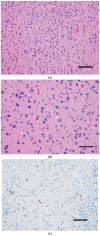New Insights into the Susceptibility of Immunocompetent Mice to Usutu Virus
- PMID: 32046265
- PMCID: PMC7077335
- DOI: 10.3390/v12020189
New Insights into the Susceptibility of Immunocompetent Mice to Usutu Virus
Abstract
Usutu virus (USUV) is a mosquito-borne flavivirus that shares many similarities with the closely related West Nile virus (WNV) in terms of ecology and clinical manifestations. Initially distributed in Africa, USUV emerged in Italy in 1996 and managed to co-circulate with WNV in many European countries in a similar mosquito-bird life cycle. The rapid geographic spread of USUV, the seasonal mass mortalities it causes in the European avifauna, and the increasing number of infections with neurological disease both in healthy and immunocompromised humans has stimulated interest in infection studies to delineate USUV pathogenesis. Here, we assessed the pathogenicity of two USUV isolates from a recent Belgian outbreak in immunocompetent mice. The intradermal injection of USUV gave rise to disorientation and paraplegia and was associated with neuronal death in the brain and spinal cord in a single mouse. Intranasal inoculation of USUV could also establish the infection; viral RNA was detected in the brain 15 days post-infection. Overall, this pilot study probes the suitability of this murine model for the study of USUV neuroinvasiveness and the possibility of direct transmission in mammals.
Keywords: Usutu virus; encephalitis; immunocompetent; infection; mice.
Conflict of interest statement
The authors declare no conflicts of interest.
Figures





Similar articles
-
Usutu virus-induced meningoencephalitis in immunocompetent mice is characterized by the recruitment of mononuclear cells and a proinflammatory T helper 1 response.J Virol. 2025 Mar 18;99(3):e0172424. doi: 10.1128/jvi.01724-24. Epub 2025 Feb 5. J Virol. 2025. PMID: 39907280 Free PMC article.
-
Usutu Virus: An Arbovirus on the Rise.Viruses. 2019 Jul 12;11(7):640. doi: 10.3390/v11070640. Viruses. 2019. PMID: 31336826 Free PMC article. Review.
-
Competition between Usutu virus and West Nile virus during simultaneous and sequential infection of Culex pipiens mosquitoes.Emerg Microbes Infect. 2020 Dec;9(1):2642-2652. doi: 10.1080/22221751.2020.1854623. Emerg Microbes Infect. 2020. PMID: 33215969 Free PMC article.
-
Limited susceptibility of mice to Usutu virus (USUV) infection and induction of flavivirus cross-protective immunity.Virology. 2015 Aug;482:67-71. doi: 10.1016/j.virol.2015.03.020. Epub 2015 Mar 30. Virology. 2015. PMID: 25827530
-
An overview of Usutu virus.Microbes Infect. 2017 Jul-Aug;19(7-8):382-387. doi: 10.1016/j.micinf.2017.05.003. Epub 2017 Jun 8. Microbes Infect. 2017. PMID: 28602915 Review.
Cited by
-
Differential effects of Usutu and West Nile viruses on neuroinflammation, immune cell recruitment and blood-brain barrier integrity.Emerg Microbes Infect. 2023 Dec;12(1):2156815. doi: 10.1080/22221751.2022.2156815. Emerg Microbes Infect. 2023. PMID: 36495563 Free PMC article.
-
Dose and strain dependent lethality of Usutu virus in an Ifnar-/- mouse model.Npj Viruses. 2025 Jan 28;3(1):6. doi: 10.1038/s44298-025-00089-x. Npj Viruses. 2025. PMID: 40295862 Free PMC article.
-
In Vitro and In Vivo Models to Study the Zoonotic Mosquito-Borne Usutu Virus.Viruses. 2020 Sep 30;12(10):1116. doi: 10.3390/v12101116. Viruses. 2020. PMID: 33008141 Free PMC article. Review.
-
Differential neurovirulence of Usutu virus lineages in mice and neuronal cells.J Neuroinflammation. 2021 Jan 6;18(1):11. doi: 10.1186/s12974-020-02060-4. J Neuroinflammation. 2021. PMID: 33407600 Free PMC article.
-
Evaluation of Non-Vector Transmission of Usutu Virus in Domestic Canaries (Serinus canaria).Viruses. 2024 Jan 3;16(1):79. doi: 10.3390/v16010079. Viruses. 2024. PMID: 38257779 Free PMC article.
References
-
- Lindenbach B.D., Murray C.L., Thiel H.-J., Rice C.M. Flaviviridae. In: Knipe D.M., Howley P.M., editors. Fields Virology. LippincottWilliams & Wilkins; Philadelphia, PA, USA: 2013. pp. 712–746.
-
- Benzarti E., Sarlet M., Franssen M., Cadar D., Schmidt-Chanasit J., Rivas J., Linden A., Desmecht D., Garigliany M. Usutu Virus Epizootic in Belgium in 2017 and 2018: Evidence of Virus Endemization and Ongoing Introduction Events. Vector Borne Zoonotic Dis. 2019;20:43–50. doi: 10.1089/vbz.2019.2469. - DOI - PubMed
-
- García-bocanegra I., Paniagua J., Gutiérrez-guzmán A.V., Lecollinet S., Boadella M., Arenas-montes A., Cano-terriza D., Lowenski S., Gortázar C., Höfle U. Spatio-temporal trends and risk factors affecting West Nile virus and related flavivirus exposure in Spanish wild ruminants. BMC Vet. Res. 2016;12:249. doi: 10.1186/s12917-016-0876-4. - DOI - PMC - PubMed
Publication types
MeSH terms
Substances
Supplementary concepts
LinkOut - more resources
Full Text Sources

